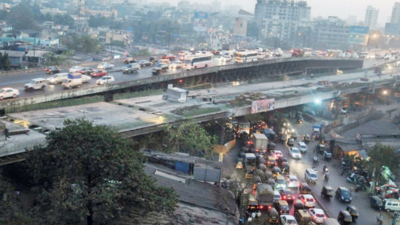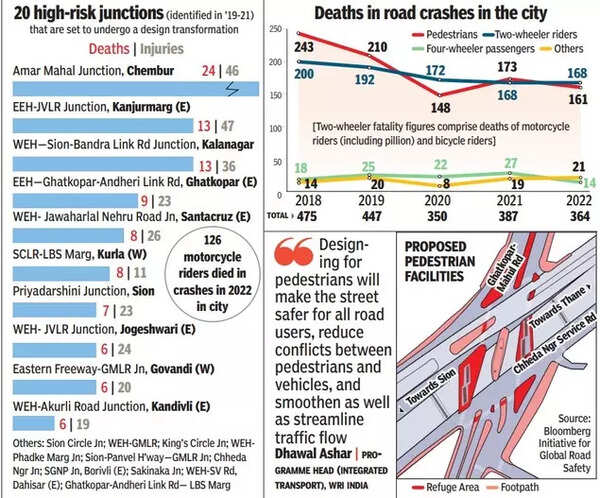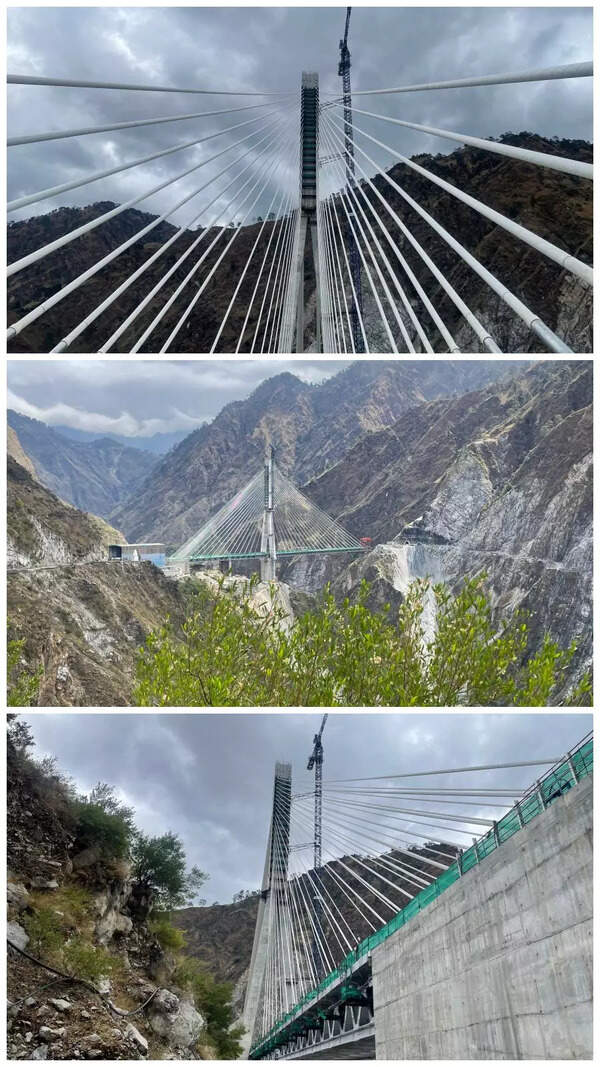- News
- City News
- mumbai News
- After 132 deaths, 20 killer Mumbai road junctions to get a design reform
Trending Topics
After 132 deaths, 20 killer Mumbai road junctions to get a design reform

The Amar Mahal Junction has eight intersecting arms and is a nightmare for pedestrians
MUMBAI: Amar Mahal Junction in Chembur, the deadliest intersection in the city with 24 fatalities in three years, is among 20 high-risk crossings that will be redesigned by the BMC to make them safer. These junctions together witnessed 132 deaths in the 2019-2021 period.
The BMC has joined hands with Bloomberg Philanthropies to transform these junctions by widening pedestrian crossings and footpaths, adding refuge areas to reduce crossing distances, and using traffic calming measures such as speed breakers and rumble strips.

Amar Mahal Junction witnessed nearly double the deaths reported at Kalanagar Junction, the second-ranked high-risk intersection with 13 deaths in three years. A majority of these high-risk locations, including the junction of Ghatkopar Andheri Link Road with Eastern Express Highway, are in the eastern and western suburbs.
Amar Mahal, other junctions to focus on pedestrian needs
Road safety experts who visited Amar Mahal Junction on Thursday pointed out multiple conflict points and the lack of proper channelisation of traffic there. So chaotic was the traffic that traffic policemen had to be roped in as escorts to cross it safely. The junction has eight intersecting arms with a very high traffic volume as well as heavy pedestrian movement. With a lack of pedestrian crossings or refuge areas, people were confused and darted between vehicles, risking their lives. “Signal jumping is reported often here. We are required to post two traffic policemen and at least three wardens here at all times,” said senior inspector Sanjay Bhalerao of the Chembur traffic division, barely audible over the constant blaring of motor horns.
The experts said road infrastructure should be easy to figure out and self-regulate people and traffic, and the Amar Mahal Junction poses a challenge to this. “Proposed design interventions will compact the junction, align travel lanes and define the space for people, especially pedestrians. From 8,000 square metres, the junction will be made a compact 3,700 square metres without reducing any travel lanes. Almost 1,500 square metres of public space will be reclaimed,” said Saurabh Jain, a consultant with non-profit WRI India, which is a partner under the Bloomberg Initiative for Global Road Safety (BIGRS).
Experts from BIGRS will also be involved in reworking the road geometry, fixing signage, creating continuous pedestrian facilities and reducing vehicular speeding through design at Dharavi depot. Data on road crashes in the city from 2015 to 2022 shows that most fatalities involve pedestrians and motorcyclists. The two made up 89% of all road accident deaths last year. Previously, road junctions in south and central Mumbai have been redesigned for greater safety under BIGRS, including Nagpada Junction, Mela Junction in Mahalaxmi and Bharatmata in Parel. Around 9.5km of LBS Road was also made safer.
The BMC has joined hands with Bloomberg Philanthropies to transform these junctions by widening pedestrian crossings and footpaths, adding refuge areas to reduce crossing distances, and using traffic calming measures such as speed breakers and rumble strips.

Amar Mahal Junction witnessed nearly double the deaths reported at Kalanagar Junction, the second-ranked high-risk intersection with 13 deaths in three years. A majority of these high-risk locations, including the junction of Ghatkopar Andheri Link Road with Eastern Express Highway, are in the eastern and western suburbs.
Amar Mahal, other junctions to focus on pedestrian needs
Road safety experts who visited Amar Mahal Junction on Thursday pointed out multiple conflict points and the lack of proper channelisation of traffic there. So chaotic was the traffic that traffic policemen had to be roped in as escorts to cross it safely. The junction has eight intersecting arms with a very high traffic volume as well as heavy pedestrian movement. With a lack of pedestrian crossings or refuge areas, people were confused and darted between vehicles, risking their lives. “Signal jumping is reported often here. We are required to post two traffic policemen and at least three wardens here at all times,” said senior inspector Sanjay Bhalerao of the Chembur traffic division, barely audible over the constant blaring of motor horns.
TimesView
Year after year, data shows us pedestrians are among the highest casualties in road crashes. Yet, pedestrian infrastructure like footpaths or well-marked zebra crossings are of poor quality on most city roads. Evidence-based infrastructural improvements should have been made at the 20 high-risk pedestrian intersections on a priority a long time back. It is indeed surprising that the BMC has woken up to this problem now.
The experts said road infrastructure should be easy to figure out and self-regulate people and traffic, and the Amar Mahal Junction poses a challenge to this. “Proposed design interventions will compact the junction, align travel lanes and define the space for people, especially pedestrians. From 8,000 square metres, the junction will be made a compact 3,700 square metres without reducing any travel lanes. Almost 1,500 square metres of public space will be reclaimed,” said Saurabh Jain, a consultant with non-profit WRI India, which is a partner under the Bloomberg Initiative for Global Road Safety (BIGRS).
Experts from BIGRS will also be involved in reworking the road geometry, fixing signage, creating continuous pedestrian facilities and reducing vehicular speeding through design at Dharavi depot. Data on road crashes in the city from 2015 to 2022 shows that most fatalities involve pedestrians and motorcyclists. The two made up 89% of all road accident deaths last year. Previously, road junctions in south and central Mumbai have been redesigned for greater safety under BIGRS, including Nagpada Junction, Mela Junction in Mahalaxmi and Bharatmata in Parel. Around 9.5km of LBS Road was also made safer.

About the Author
Nitasha NatuNitasha Natu is a Senior Assistant Editor with the Times of India and writes on gender, human rights, road safety and law enforcement. She has received the Laadli Media & Advertising Award for Gender Sensitivity in 2021. She tweets @nnatuTOI
Start a Conversation
FOLLOW US ON SOCIAL MEDIA
FacebookTwitterInstagramKOO APPYOUTUBE










